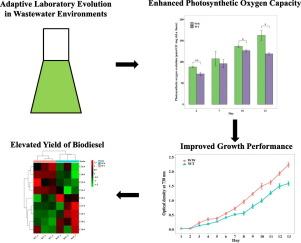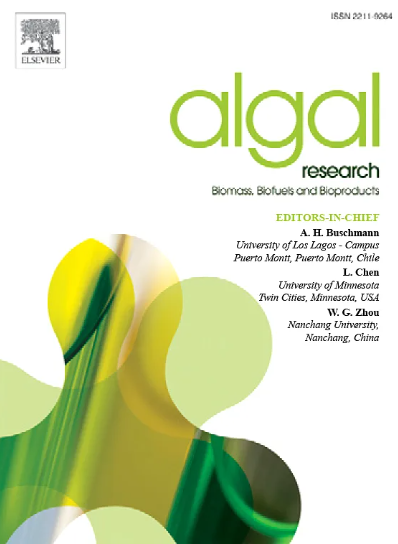Molecular insights into the enhanced growth of cyanobacteria by adaptive laboratory evolution in wastewater environments
IF 4.6
2区 生物学
Q1 BIOTECHNOLOGY & APPLIED MICROBIOLOGY
Algal Research-Biomass Biofuels and Bioproducts
Pub Date : 2024-10-01
DOI:10.1016/j.algal.2024.103724
引用次数: 0
Abstract
The expansion of population leads to an increase in nutrient-rich wastewater, posing a threat to the ecosystem. The cultivation of economically beneficial cyanobacteria consumes amounts of freshwater, exacerbating the depletion of freshwater resources. This study investigates the potential of utilizing adaptive laboratory evolution (ALE) to enhance the growth performance of Synechocystis sp. PCC 6803, a model cyanobacterium, in wastewater. After 374 days of ALE, a strain designated as WW was successfully evolved. When cultivated in wastewater, WW exhibited a specific growth rate of 0.317 per day and achieved a dry weight of 0.693 g/L by the 13th day, outperforming the wild type. WW achieved removal efficiencies of 35.55 % for total nitrogen and 60.95 % for total phosphorus in the wastewater. RNA sequencing and photosynthetic measurements revealed that enhanced photosynthetic capacity in the WW contributes to its superior growth performance. The lipid content in WW was 16.19 %, with a notable increase in the proportion of polyunsaturated fatty acids. The shift in fatty acid composition has a consequential impact on biodiesel index, including oxidation stability and saponification number. This study not only demonstrates the effectiveness of ALE in enhancing the growth of cyanobacteria in wastewater for biofuel production, but also offers significant insights into the molecular mechanisms that drive this improved performance.

通过适应性实验室进化提高蓝藻在废水环境中生长的分子见解
人口膨胀导致富含营养物质的废水增加,对生态系统构成威胁。对经济有益的蓝藻的培育需要消耗大量淡水,加剧了淡水资源的枯竭。本研究探讨了利用实验室适应性进化(ALE)提高蓝藻模型 Synechocystis sp.经过 374 天的适应性实验室进化,一株名为 WW 的菌株成功进化。在废水中培养时,WW 的特定生长率为每天 0.317,到第 13 天时干重达到 0.693 克/升,优于野生型。WW 对废水中总氮和总磷的去除率分别为 35.55% 和 60.95%。RNA 测序和光合作用测量结果表明,WW光合作用能力的增强是其生长性能优越的原因之一。WW 中的脂质含量为 16.19%,多不饱和脂肪酸的比例明显增加。脂肪酸组成的变化会对生物柴油的氧化稳定性和皂化度等指标产生影响。这项研究不仅证明了 ALE 在提高废水中蓝藻的生长以生产生物燃料方面的有效性,而且还为我们深入了解驱动这种性能改善的分子机制提供了重要依据。
本文章由计算机程序翻译,如有差异,请以英文原文为准。
求助全文
约1分钟内获得全文
求助全文
来源期刊

Algal Research-Biomass Biofuels and Bioproducts
BIOTECHNOLOGY & APPLIED MICROBIOLOGY-
CiteScore
9.40
自引率
7.80%
发文量
332
期刊介绍:
Algal Research is an international phycology journal covering all areas of emerging technologies in algae biology, biomass production, cultivation, harvesting, extraction, bioproducts, biorefinery, engineering, and econometrics. Algae is defined to include cyanobacteria, microalgae, and protists and symbionts of interest in biotechnology. The journal publishes original research and reviews for the following scope: algal biology, including but not exclusive to: phylogeny, biodiversity, molecular traits, metabolic regulation, and genetic engineering, algal cultivation, e.g. phototrophic systems, heterotrophic systems, and mixotrophic systems, algal harvesting and extraction systems, biotechnology to convert algal biomass and components into biofuels and bioproducts, e.g., nutraceuticals, pharmaceuticals, animal feed, plastics, etc. algal products and their economic assessment
 求助内容:
求助内容: 应助结果提醒方式:
应助结果提醒方式:


